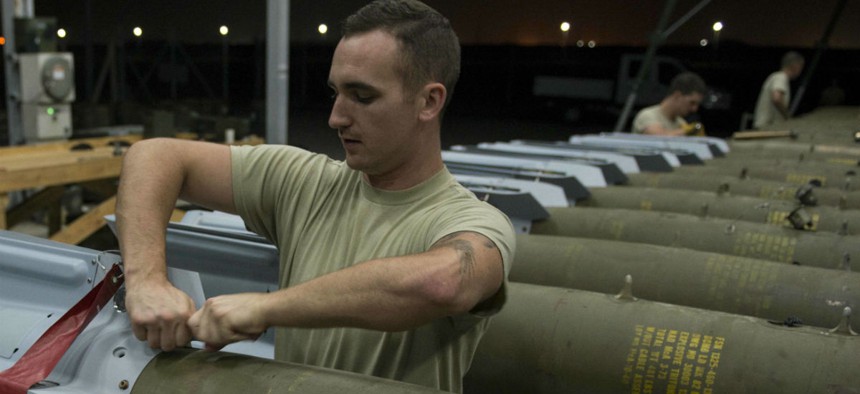Air Force: We’re Low on Bombs Because Congress Can’t Pass a Budget
It’s hard to persuade arms makers to boost production, even to fight ISIS, without cash on the barrelhead.
More than three years into its airstrike campaign against the Islamic State in Iraq and Syria, the Pentagon is still struggling to replenish its bomb and missile stockpiles. Now it’s Congress’ budgetary inaction that is thwarting Air Force efforts to persuade arms makers to increase production.
“Probably the most important thing with respect to munitions is to get a budget,” Air Force Secretary Heather Wilson said Tuesday at an Air Force Association-sponsored conference in the Washington suburbs.
Wilson blamed Congress’ decision to freeze spending for the first three months of fiscal 2018 at lower 2017 levels, instead of passing a budget in time for the fiscal year to start on Oct. 1.
“We have a continuing resolution and budget uncertainty impacts our ability to work with industry and give them certainty on the amount that we’re going to buy and ramping that up where we can,” Wilson said. “We have been engaged with industry directly probably at least four or five months ago, starting at the very senior level with our logistics and munitions people to see how we can expand the production capacity of precision weapons. The most important thing that we have to do now is get a budget.”
The U.S. military is dropping about 100 precision weapons per day on ISIS in Iraq and Syria, Wilson said. As of Aug. 31, U.S. and allies aircraft had dropped 98,532 bombs since the campaign began in August 2014, according to Air Forces Central Command data.
Top military officials have said the Pentagon has had to bring weapons from elsewhere in the world to the Middle East to keep up with the pace of the strikes.
In their 2018 budget proposal, Air Force leaders requested funds to boost production of precision weapons. But until a budget is passed, they cannot. For example, they want to more than double the production of Lockheed Martin's Hellfire missile from about 1,500 in 2017 to more than 3,600 in 2018. The same is true for the Small Diameter Bomb. One version is made by Boeing, the other Raytheon. About 4,500 SDBs were included in the 2017 budget, but more than 7,300 are in the 2018 spending request. The two bombs are among those frequently used in the ISIS campaign.
Defense firms are looking for budget certainly, Wilson said, because they must make workforce and capital investments in order to boost production.
“If we’re going to have a continuing resolution for three months or six months out of the 12-month year, how are they going to manage that,” she said. “It becomes a real problem when you’re trying to create a relationship of trust to allow a company to do capital investment to provide for the needs of the warfighter.”
NEXT STORY: Trump Threatens to 'Totally Destroy North Korea'








